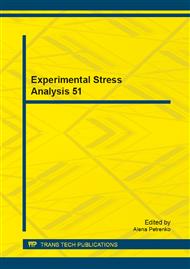[1]
ASTM International, Standard Test Method for Determining Residual Stresses by the Hole-Drilling Strain Gage Method. Designation: E 837-01. USA, updated in January 2002, pp.1-10.
DOI: 10.1520/e0837-01e01
Google Scholar
[2]
Timoshenko, S., Theory of Elasticity (McGraf-Hill Book Company, New York and London, 1934. pp.52-81).
Google Scholar
[3]
Vishay Micro-Measurements, Measurement of Residual Stresses by the Hole-Drilling Strain Gage Method (Tech Note TN-503, Revision 09, USA, 2007, pp.19-33).
Google Scholar
[4]
Drmola, J.: Verify the effect of ovality of the experimental hole for hole-drilling method to identify state of stress, diploma thesis, CTU in Prague, (2012).
Google Scholar
[5]
Havlík, V.: Verify the effect of eccentricity of the experimental hole for hole-drilling method to identify state of stress, CTU in Prague, (2012).
Google Scholar
[6]
Ješina, Z.: Verification of the effect of deviation of the hole perpendicularity within the hole drilling strain gage method, diploma thesis, CTU in Prague, (2013).
Google Scholar
[7]
Vítek, K.: Stress State Identification By Numerical Simulation of the Hole Drilling Principle – Part A and B, Proceedings of 46th International Scientific Conference Experimental Stress Analysis 2008. (TU Ostrava and Czech Society for Mechanics, Ostrava, 2008), p.271.
Google Scholar
[8]
Vítek, K., Havlík, V. : Verification of the eccentric hole influence on accuracy of the residual stress determination by Hole-drilling strain gage method, 50th annual konference on experimental analysis - EAN 2012, ČSM and CTU in Prague, Tábor, 4. 6. - 7. 6 2012, ISBN: 978-80-01-05060-6, pp.525-532.
Google Scholar
[9]
Vítek, K., Regression Model of the Hole Drilling Principle for the Stress State Identification, Proceedings of 49th International Scientific Conference Experimental Stress Analysis 2011. (Brno University of Technology and Czech Society for Mechanics, Brno, 2011), p.423 – 428, ISBN 978-80-214-4275-7, (2011).
Google Scholar
[10]
Vítek, K.: Coefficient Functions of Hole-Drilling Method, 50th annual konference on experimental analysis - EAN 2012, ČSM and CTU in Prague, Tábor, 4. 6. - 7. 6 2012, ISBN: 978-80-01-05060-6, pp.515-524.
Google Scholar


